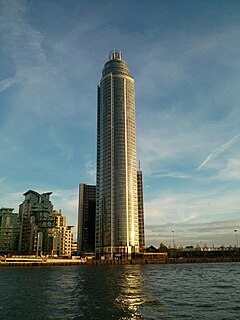St George Wharf Tower
| St George Wharf Tower | |
|---|---|

The tower in September 2013
|
|
| General information | |
| Status | Complete |
| Location | St George Wharf, Nine Elms Lane, Vauxhall, London, England |
| Coordinates | 51°29′6″N 0°7′38″W / 51.48500°N 0.12722°WCoordinates: 51°29′6″N 0°7′38″W / 51.48500°N 0.12722°W |
| Construction started | March 2010 |
| Completed | January 2014 |
| Height | |
| Roof | 181 metres (594 ft) |
| Technical details | |
| Floor count | 52 |
| Floor area | 223 flats |
| Design and construction | |
| Architect | Broadway Malyan |
| Structural engineer | WYG, Robert Bird Group |
| Main contractor | Brookfield Multiplex |
St George Wharf Tower, also known as the Vauxhall Tower, is a residential skyscraper in Vauxhall, London, and part of the St George Wharf development. At 181 metres (594 ft) tall with 50 storeys, it is the eighth tallest building in London and the tallest residential building in the UK.
The building's construction crane was hit by a helicopter in January 2013, causing two deaths.
The Tower's floor-plan design is based on the shape of a Catherine wheel and is typically divided into five apartments per floor with separating walls radiating out from the central core.
Sky gardens provide residents with a semi-external space stepped forward from the pure circular plan, creating steps in the façade that accentuate the building's height and provide variety and interest in the detailing of the otherwise minimal cladding.
The building is divided into three distinct parts – a base that houses the communal facilities of the building including a lobby, business lounge, gym, spa and swimming pool; a middle section containing most of the apartments; and an upper section where the façade reduces in diameter to provide 360° terraces and a wind turbine that tops the structure.
The wind turbine, manufactured by British green-technology company Matilda's Planet, powers the tower's common lighting, whilst creating virtually no noise or vibration. At the base of the tower, water is drawn from the London Aquifer and heat-pump technology is used to remove warmth from the water in the winter to heat the apartments. In comparison to similar buildings, the tower requires one third of the energy, and produces between one-half and two-thirds of typical CO2 emissions. It is triple-glazed to minimise heat loss in winter and heat gain in summer, with low-e glazing and ventilated blinds between the glazing to further reduce heat gain from direct sunlight.
Special stairs for the luxury lower penthouse apartments are supplied. These apartments and stairs are a mirror of each other. In one of these apartments there is a 360-degree view across the whole of London. The highest swimming pool in London is located in this apartment.
Following ongoing advice from the government architectural body, the Commission for Architecture and the Built Environment, two revised planning applications were submitted and subsequently withdrawn. A final decision was made by then Deputy Prime Minister John Prescott in April 2005, and the tower was approved, against the decision of the planning inspector and despite warnings from his own advisers that it “could set a precedent for the indiscriminate scattering of very tall buildings across London”. This has been the subject of considerable controversy, owing to the tower's height and its proximity to the Palace of Westminster.
...
Wikipedia
